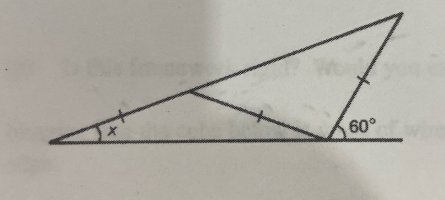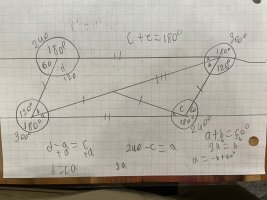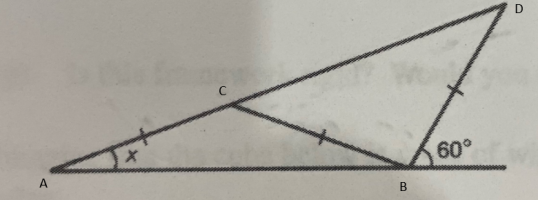drchrisdvm2009
New member
- Joined
- Aug 30, 2022
- Messages
- 4
Hi everyone! I'm a parent to some incredibly smart kids. We homeschool, and I'm having trouble finding an answer to a problem. (I'll post a photo). Any help on how to get the solution is greatly appreciated. I think we are CLOSE, but I'm coming up with something different than the answer key.

The question has two isosceles triangles connected by one of their sides (that are equal). We are given a single angle outside of the two triangles, of 60 degrees. We are asked to solve for x, which is the equal angle of a second triangle. How we are going about this is as follows:
1) We know that the left sided triangle has two angles X and the vertex angle is 180-2x.
2) we know that the vertex angle of the second triangle then has to be 120-x
3) If we label the second triangle, the opposite angles can be labeled as Y.
4) This also means that the vertex of the second triangle can also equal 120-2y.
5) The straight line across the top of the two triangles would equal 180-y, or 180-2x.
6) This is where I fail and can't figure out how to bring it home. I THOUGHT I could go y=2x at that point, or X=1/2y and then plug it back in, but I'm ripping my hair out, next to my wife and two children. One kid is trying to do bisecting lines to make right angles, the other is following in the same format I was going.
HELP!
Thanks so much in advance.
Chris

The question has two isosceles triangles connected by one of their sides (that are equal). We are given a single angle outside of the two triangles, of 60 degrees. We are asked to solve for x, which is the equal angle of a second triangle. How we are going about this is as follows:
1) We know that the left sided triangle has two angles X and the vertex angle is 180-2x.
2) we know that the vertex angle of the second triangle then has to be 120-x
3) If we label the second triangle, the opposite angles can be labeled as Y.
4) This also means that the vertex of the second triangle can also equal 120-2y.
5) The straight line across the top of the two triangles would equal 180-y, or 180-2x.
6) This is where I fail and can't figure out how to bring it home. I THOUGHT I could go y=2x at that point, or X=1/2y and then plug it back in, but I'm ripping my hair out, next to my wife and two children. One kid is trying to do bisecting lines to make right angles, the other is following in the same format I was going.
HELP!
Thanks so much in advance.
Chris




